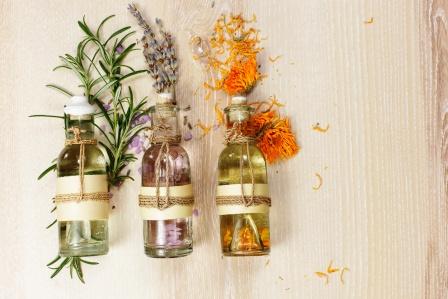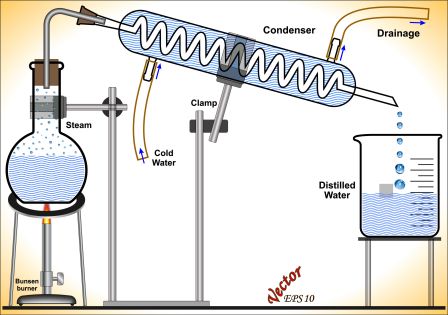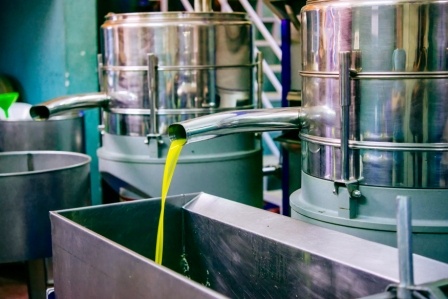Essential Oils Benefits, Usage, Side Effects, Types, Advantages

Article by Dr Raghuram Y.S. MD (Ay) and Dr Manasa, B.A.M.S
Any oil which contains ‘the essence of the plant’s fragrance’ i.e. the characteristic fragrance of the plant from which it is derived is called an ‘Essential Oil’.
Some oils are extracted or derived from the plant and parts of the plants. These oils carry the essence or fragrance of the plant. These oils are called essential oils.
Therefore the term ‘essential’ has been used in terms of ‘fragrance’.
Table of Contents
Introduction
Definition based on the composition and ingredients of essential oil:
‘An essential oil is a concentrated hydrophobic liquid containing volatile aroma compounds from plants’.
Other names
- Volatile oils
- Ethereal oils
- Aetherolea
- Oil of the plant (ex. Oil of clove)

Methods of essential oil extraction
Methods in which Essential Oils are extracted from plants
Distillation
Distillation (using steam) –
Raw plant material (flowers, leaves, wood, bark, roots, seeds, peel) are put in distillation apparatus. The steam passes over these parts and vaporizes the volatile compounds in them. As the vapors flow through the coil they condense into liquid. This liquid is collected in a vessel.
Examples of the essential oils that are distilled –
- Lavender oil
- Peppermint oil
- Tea tree oil
- Patchouli
- Eucalyptus oil
The re-condensed water (which is collected) is called hydrosol (herbal distillate, hydrolat, plant water essence). These are sold as another fragrant product.
Examples of hydrosols are –
- Rose water
- Lavender water
- Lemon balm
- Orange blossom water etc
Expression
Expression means extraction of oils by pressing the source. All essential oils were extracted by expression or pressing before distillation was discovered. The oil is extracted by mechanical pressing or cold pressing.
Example – Citrus peel oils are expressed. Lemon oils or sweet orange oils are obtained as byproducts of citrus industry.
Solvent extraction
In this method a solvent such as hexane or super-critical carbon dioxide is used to extract the oils from certain flowers. These flowers contain too little volatile oil. Therefore they cannot be expressed. Also, their chemical components are very delicate and easily denatured by the high heat used in steam distillation. Therefore the distillation cannot be used.
Extracts from hexane and other hydrophobic solvents are called concretes. Concretes are a mixture of essential oil, waxes, resins and other oil-soluble plant materials.
Absolute oil extraction
Concretes obtained in solvent extraction are fragrant but they contain abundant of resins and non-fragrant waxes. Another solvent like ethyl alcohol is used to extract fragrant oils from concrete. The remnant left over after waxes, lipids, precipitates and ethanol are removed is called absolute.
Supercritical carbon dioxide is used to extract both waxes and essential oils that make up the concrete. Subsequent processing with liquid carbon dioxide will separate the waxes from the essential oils.
Resin tapping
Essential oils are also extracted from natural exudates and resins (resinoids) of the trees. The aromatic essences are collected from the resin (gum like substance) that oozes out of the tree barks when trees are tapped. Another type of aromatic oil comes from traditional destructive distillation method that gives rise to fossilized amber oil. In this process, the starting material (ex. Benzoin resin) is super-heated and cooked until an oil substance is obtained from the solid (starting) material. Thus, oil can be obtained from something that did not really have oil in it in the first place.

Cold pressing
Cold pressing –
Cold pressing is preferred while extracting oil from seed. This process ensures that the resulting oil is 100% pure and retains all properties of the plant. The seeds are crushed and pressed and its oil is forced out.
Oil Soak
In this method, the herbs are soaked in the carrier oil. Example, for mint essential oil we can soak mint in a carrier oil like coconut oil. This mixture is left for about 2 weeks. Later the mint is strained. The carrier oil will now have the mint extract and the resultant oil is mint essential oil. Similarly other herbs like basil, lavender and rosemary can be soaked in carrier oil and their essential oil obtained. These oils should be properly stored especially in an amber-colored jar (preferably glass) and should be stored in a cool and dry place. It should be kept away from heat and moisture.
Utility of essential oils
Areas of usage of essential oils
Essential oils have wide array of uses. They are used in –
- Perfumes
- Cosmetics
- Soaps
- As food and drink flavors
- For adding scents to incense
- For adding scent to household cleaning products
- Foods
- Beverages
- Confectioneries

Pharmacological uses
Pharmacological and Medical uses of certain Essential Oils
Cavracol (a terpene found in oregano oil) – Inhibits growth of several bacteria strains including E. coli and Bacillus cereus.
Thymol (found in oil of thyme, a common spice) – Strong anti-microbial, reduces bacterial resistance to common drugs like penicillin, induces antibiotic susceptibility in drug-resistant pathogens, powerful antioxidant, fungicide (against fluconazole-resistant strains), has anti-tumor properties
Juniper and agathosma – Diuretic property
Clove oil or Eugenol – Popular antiseptics and local anesthetics in dentistry for hundreds of years
Eucalyptus oil – used as primary cleansing / disinfecting agent added to soaped mop and countertop cleaning solutions. It also possesses insect and vermin control properties.
Balsam of Peru – is an essential oil derived from Myroxylon. It is used in food and drink flavor, perfumes, toiletries (for fragrance), medicine (healing) and pharmaceutical items (healing property).
Lavender Essential Oil – It is used in the production of perfume. It is also used as an insect repellent.
Some essential oils which act on upper respiratory tract and bronchus act as mild expectorants and decongestants. Those which are locally anesthetic counterirritants have anti-tussive effect.
Aromatherapy – Some Essential oils are used in aromatherapy. In this, healing effects are ascribed to the aromatic compounds in essential oils and other plant extracts. These therapies appear to be useful in inducing relaxation when used in the form of massage.
Essential oils ill effects
Ill effects of certain essential oils
Oral consumption of eucalyptus oils, menthol, capsaicin, anise and camphor – especially in high concentrations may prove dangerous. Ill effects include burning sensation, salivation etc. they act like carminative in stomach and antispasmodic in gut.
Tea tree oils – may cause contact dermatitis
Turpentine oil and camphor oil – cause rubefacient irritation and counterirritant numbness
Menthol – cause feeling of cold followed by burning sensation
Balsam of Peru – causes allergic reactions, one among the top five allergens
Lavender Essential Oil & Tea Tree Oil – They are shown to be estrogenic and anti-androgenic, causing problems for prepubescent boys and pregnant women (not proved in case of tea tree oil)
Citrus Peel Oils – are photo-sensitizers, increase skin’s vulnerability to sunlight
Tea tree oil, Lavender and Citrus Oils are classed as Class 3 flammable liquid
Internal use of some essential oils may be dangerous to pregnant women. They can be abortifacients. They should not be used during pregnancy.
Some essential oils used therapeutically, for aromatherapy or in foods may consist of traces of pesticide residues which may pose dangerous threat for health and life
Some essential oils cause allergic reactions and skin irritation when used for massage as a part of aromatherapy
Dilution of essential oils
How are essential oils diluted?
Essential oils need to be diluted or mixed in some carrier oil. These essential oils are actually ‘oil-loving’ or lipophilic in nature. These compounds do not mix with water. They can be diluted in –
- Ethanol
- Polyethylene glycol
- Carrier oil (any vegetable oil like jojoba oil, coconut oil, wheat germ, olive or avocado oil), especially when essential oils are used for topical care (skin care)
Raw materials
Raw materials used for deriving essential oils
Essential oils, as already said are derived from sections of plants. Examples are as given below –
Bark – Cinnamon, Cassia
Flowers – Rose, Jasmine, Lavender, Clove, Orange, Cannabis, Chamomile, etc
Leaves – Basil, Wintergreen, Lemongrass, Eucalyptus, Tea tree, Peppermint, Rosemary, Bay leaf, Cinnamon, Guava, Oregano, Pine, Thyme, Spearmint etc
Woods – Sandalwood, Rosewood, Camphor, Cedar, Agarwood etc
Roots – Valerian etc
Rhizome – Ginger, Galangal etc
Seeds – Cumin, Flax, Celery, Anise, Nutmeg oil
Resin – Myrrh, Frankincense, Benzoin, Labdanum etc
Peel – Grapefruit, Lemon, Lime, Bergamot, Orange, etc
Berries – Juniper, Allspice etc
Toxins related to essential oils
Toxins related to essential oils and LD50
LD50 or median lethal dose for common oils – is a dose needed to kill half the members of a tested animal population. It is a guideline to understand and estimate toxic values in essential oils. The values can vary due to differences in tested species and testing conditions.
Oral LD50 – Lethal dose of essential oils when taken orally (by mouth)
Dermal LD50 – Lethal dose of essential oils when applied on skin
The Oral LD50 & Dermal LD50 for some essential oils has been tabulated below –
| Sl No | Common name of essential oil or
Raw material used | Oral LD50 | Dermal LD50 |
| 1 | Neem | 14 g/kg | ? 2 g/kg |
| 2 | Lemon Myrtle | 2.43 g/kg | 2.25 g/kg |
| 3 | Indian Frankincense (Boswellia serrata) | ? 2 g/kg | ? 2 g/kg |
| 4 | Cedar-wood | ? 5 g/kg | ? 5 g/kg |
| 5 | Cassia | 2.8 g/kg | 0.32 g/kg |
| 6 | White Camphor
(Cinnamomum camphora, extracted from the leaves) | ? 5 g/kg | ? 5 g/kg |
| 7 | Yellow Camphor
(Cinnamomum camphora, extracted from the bark) | 3.73 g/kg | ? 5 g/kg |
| 8 | Hot Oil
(Cinnamomum camphora, oil extracted from the leaves) | 3.80 g/kg | ? 5 g/kg |
| 9 | Ylang-ylang | ? 5 g/kg | ? 5 g/kg |
| 10 | Roman chamomile | ? 5 g/kg | ? 5 g/kg |
History of Essential oils
Throughout history, we can find the evidences of essential oils been used medicinally.
Earliest recorded mention of techniques and methods used in production of essential oils – Ibn al-Baitar (1188-1248),
an Al-Andalusian (Muslim controlled Spain) physician, chemist and pharmacist
Popularity of aromatherapy has generated interest in use of essential oils in recent years.
Click to Consult Dr Raghuram Y.S. MD (Ayu)










